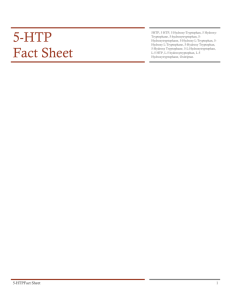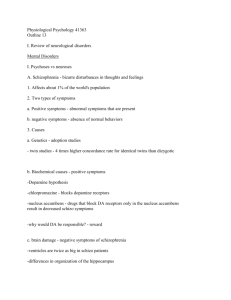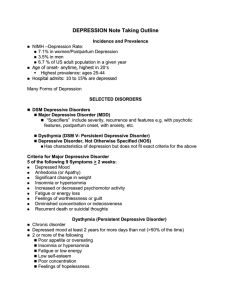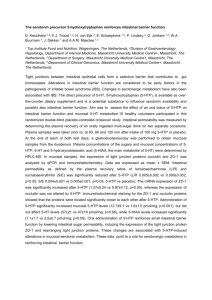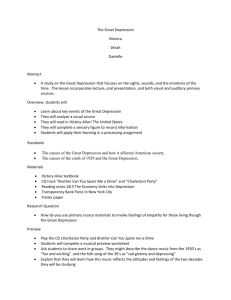Neurogistics Reference List
advertisement
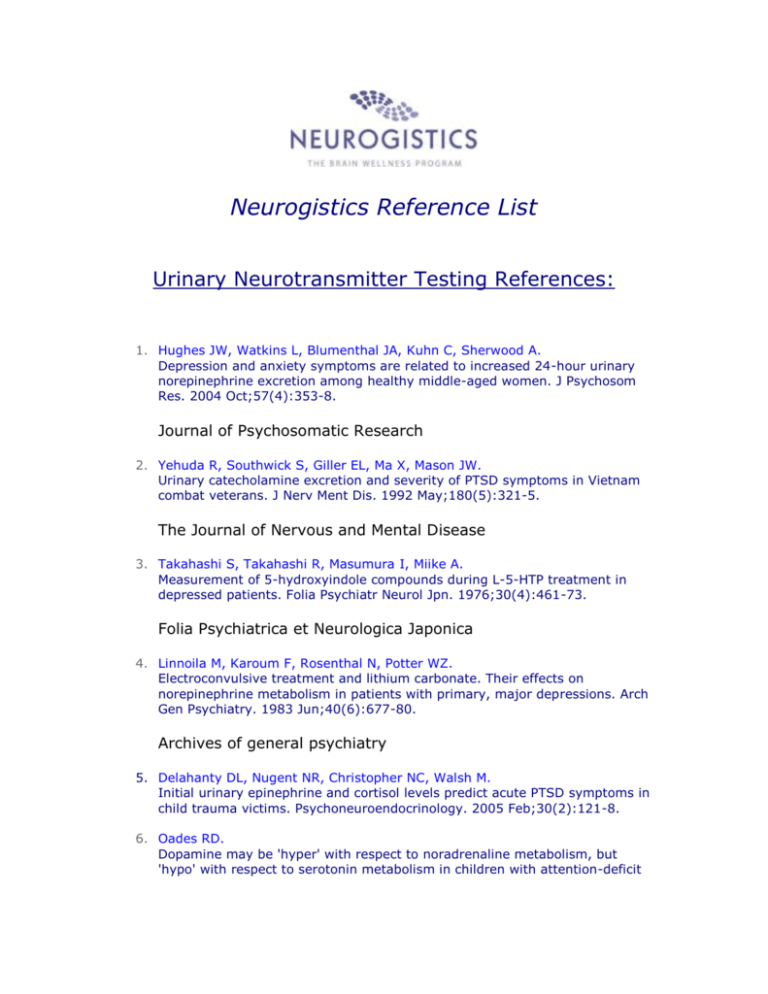
Neurogistics Reference List Urinary Neurotransmitter Testing References: 1. Hughes JW, Watkins L, Blumenthal JA, Kuhn C, Sherwood A. Depression and anxiety symptoms are related to increased 24-hour urinary norepinephrine excretion among healthy middle-aged women. J Psychosom Res. 2004 Oct;57(4):353-8. Journal of Psychosomatic Research 2. Yehuda R, Southwick S, Giller EL, Ma X, Mason JW. Urinary catecholamine excretion and severity of PTSD symptoms in Vietnam combat veterans. J Nerv Ment Dis. 1992 May;180(5):321-5. The Journal of Nervous and Mental Disease 3. Takahashi S, Takahashi R, Masumura I, Miike A. Measurement of 5-hydroxyindole compounds during L-5-HTP treatment in depressed patients. Folia Psychiatr Neurol Jpn. 1976;30(4):461-73. Folia Psychiatrica et Neurologica Japonica 4. Linnoila M, Karoum F, Rosenthal N, Potter WZ. Electroconvulsive treatment and lithium carbonate. Their effects on norepinephrine metabolism in patients with primary, major depressions. Arch Gen Psychiatry. 1983 Jun;40(6):677-80. Archives of general psychiatry 5. Delahanty DL, Nugent NR, Christopher NC, Walsh M. Initial urinary epinephrine and cortisol levels predict acute PTSD symptoms in child trauma victims. Psychoneuroendocrinology. 2005 Feb;30(2):121-8. 6. Oades RD. Dopamine may be 'hyper' with respect to noradrenaline metabolism, but 'hypo' with respect to serotonin metabolism in children with attention-deficit hyperactivity disorder. Behav Brain Res. 2002 Mar 10;130(1-2):97-102. Review. This paper describes the role of urinary neurotransmitters in relation to Attention Deficit Disorder (ADD). Behavioral Brain Research 7. Tripodianakis J, Markianos M, Sarantidis D, Agouridaki M. Biogenic amine turnover and serum cholesterol in suicide attempt. Eur Arch Psychiatry Clin Neurosci. 2002 Feb;252(1):38-43. European Archives of Psychiatry and Clinical Neuroscience 8. Lykouras L, Markianos M, Hatzimanolis J, Malliaras D, Stefanis C. Association of biogenic amine metabolites with symptomatology in delusional (psychotic) and nondelusional depressed patients. Prog Neuropsychopharmacol Biol Psychiatry. 1995 Sep;19(5):877-87. Progress in Neuro-Psychopharmacology & Biological Psychiatry 9. Hernandez-Reif M, Ironson G, Field T, Hurley J, Katz G, Diego M, Weiss S, Fletcher MA, Schanberg S, Kuhn C, Burman I. Breast cancer patients have improved immune and neuroendocrine functions following massage therapy. J Psychosom Res. 2004 Jul;57(1):45-52. Journal of Psychosomatic Research 5-HTP: 1. Birdsall TC. 5-Hydroxytryptophan: a clinically-effective serotonin precursor. Alternative Medicine Review 1998 Aug; 3(4):271-80. 2. Turner EH, Loftis, JM, Blackwell AD. Serotonin a la carte: supplementation with the serotonin precrsos 5hydroxytryptophan. Pharmacol Ther 2006; 109(3): 325-38. 3. Turner EH, Blackwell AD. 5-Hydroxytryptophan plus SSRIs for interferon-induced depression: synergistic mechanisms for normalizing synaptic serotonin. Med Hypotheses 2005;65(1):138-44. 4. Exp Brain Res. 1991;86(1):117-24. Links The role of 5-hydroxytryptophan (5-HTP) in the regulation of the sleep/wake cycle in parachlorophenylalanine (p-CPA) pretreated rat: a multiple approach study. Touret M, Sarda N, Gharib A, Geffard M, Jouvet M. Departement de Medecine Experimentale, INSERM U 52, CNRS, URA 1195, Universite Claude Bernard, Lyon, France. In the rat, the insomnia which follows the administration of parachlorophenylalanine (p-CPA), a serotonin synthesis inhibitor, is transiently reversed either by intra-cisternal injection of L-5-HTP or by an associated injection of 5-HTP and an L-aromatic-acid-decarboxylase inhibitor (benserazide). Histochemical, immunohistochemical and chemical investigations showed that 5-HTP administration does not lead to a detectable increase in cerebral 5-HT. These findings suggest that the restoration of sleep after p-CPA treatment could be mediated by the central action of 5-HTP. 2 Acute L-5-hydroxytryptophan administration inhibits carbon dioxideinduced panic in panic disorder patients. Schruers K, van Diest R, Overbeek T, Griez E. Department of Psychiatry and Neuropsychology, Institute of Brain and Behaviour, Maastricht University, P.O. Box 88, The Netherlands. koen.schruers@pn.unimaas.nl Previous research showed that lowering the availability of serotonin to the brain by tryptophan depletion increases the vulnerability of panic disorder patients for an experimental 35% CO(2) panic challenge. The results also suggested that increased availability of serotonin inhibits the response to such a challenge. In the present study, this latter possibility is examined. The reaction of 24 panic disorder patients and 24 healthy volunteers to a 35% CO(2) panic challenge was assessed following administration of 200-mg L-5-hydroxytryptophan (the immediate precursor of serotonin) or placebo. L-5-Hydroxytryptophan significantly reduced the reaction to the panic challenge in panic disorder patients, regarding subjective anxiety, panic symptom score and number of panic attacks, as opposed to placebo. No such effect was observed in the healthy volunteers. L-5-Hydroxytryptophan acts to inhibit panic, which supports a modulatory role of serotonin in panic disorder. Fibromyalgia and the serotonin pathway.6 Juhl JH. Fibromyalgia syndrome is a musculoskeletal pain and fatigue disorder manifested by diffuse myalgia, localized areas of tenderness, fatigue, lowered pain thresholds, and nonrestorative sleep. Evidence from multiple sources support the concept of decreased flux through the serotonin pathway in fibromyalgia patients. Serotonin substrate supplementation, via L-tryptophan or 5-hydroxytryptophan (5-HTP), has been shown to improve symptoms of depression, anxiety, insomnia and somatic pains in a variety of patient cohorts. Identification of low serum tryptophan and serotonin levels may be a simple way to identify persons who will respond well to this approach. Neuroendocrine response to 5-hydroxy-L-tryptophan in prepubertal children at high risk of major depressive disorder. Birmaher B, Kaufman J, Brent DA, Dahl RE, Perel JM, al-Shabbout M, Nelson B, Stull S, Rao U, Waterman GS, Williamson DE, Ryan ND. University of Pittsburgh Medical Center, Western Psychiatric Institute and Clinic, Pa., USA. BACKGROUND: Altered serotonergic function has been observed in prepubertal children and adults with an acute episode of major depressive disorder (MDD). However, it is not known whether these alterations are present prior to the onset of MDD. METHODS: A serotonergic precursor, 5-hydroxy-L-tryptophan (L-5HTP) (oxitriptan) (0.8 mg/kg), was administered through an indwelling catheter to 36 children at high risk of MDD (with high family loading for MDD), 31 children with MDD, and 23 low-risk normal controls (with low family loading for mood disorders and no history of psychopathology). Blood samples for cortisol, prolactin (PRL), and growth hormone were obtained every 15 minutes for 180 minutes, beginning 30 minutes before L-5HTP infusion. RESULTS: Children at high risk of MDD and children with MDD had similar hormonal responses following L-5HTP infusion. After controlling for baseline values, both groups secreted significantly less cortisol and more PRL than did the low-risk normal controls, with the PRL finding being limited to girls. There were no between-group differences in baseline cortisol, PRL, or growth hormone secretion measures. CONCLUSIONS: Before the onset of affective illness, high-risk children had the same pattern of neuroendocrine response to the L-5HTP challenge as did children with MDD. These results extend earlier findings of altered serotonergic regulation in association with early-onset depression and indicate that these alterations may represent a trait marker for depression in children. PMID: 9400347 [PubMed - indexed for MEDLINE] In search of the mode of action of antidepressants: 5-HTP/tyrosine mixtures in depression.9 van Praag HM. For a long time, antidepressants have been considered to act via enhancement of central MA-ergic activity (due to reuptake or MAO inhibition). An alternative hypothesis holds that their action is based on down-regulation of MA-ergic activity (due to decrease in density or sensitivity of certain receptor populations). In this chapter I have discussed the likelihood of both hypotheses and have reached the conclusion that the first one is the more plausible. I have discussed the following arguments: The 5-HT precursor 5-HTP, which is transformed to 5-HT in the brain, has antidepressant properties. There are indications that the same holds true for tyrosine, a CA precursor transformed in the brain to DA and NE. I found evidence that the 5-HTP effects in depression are potentiated by tyrosine. Since activation rather than suppression of MA-ergic activity seems to be linked to antidepressant activity, it seems likely that the signs of decreased MA metabolism that has been demonstrated in certain types of depression are the expression of a primary metabolic deficit rather than a phenomenon secondary to receptor hyper-sensitivity. Further clinical studies of 5-HT/CA precursor combinations in depression are justified. Double-blind study of 5-hydroxytryptophan versus placebo in the treatment of primary fibromyalgia syndrome. Caruso I, Sarzi Puttini P, Cazzola M, Azzolini V. Rheumatology Unit, L. Sacco Hospital, Milan, Italy. A double-blind, placebo-controlled study of the efficacy and tolerability of 5hydroxytryptophan (5-HTP) was conducted in 50 patients with primary fibromyalgia syndrome. All the clinical parameters studied were significantly improved by treatment with 5-HTP and only mild and transient side-effects were reported. Further controlled studies are required to define properly the value of 5-HTP in patients with primary fibromyalgia syndrome. L-5-hydroxytryptophan in the treatment of anxiety disorders.11 Kahn RS, Westenberg HG. Ten outpatients suffering from anxiety states (Anxiety Disorders: DSM-III) were treated with L-5-hydroxytryptophan and carbidopa. A significant reduction in anxiety was observed on three different anxiety scales. It is suggested that 5-HT systems may be involved in the mediation of anxiety. L-Tyrosine: 1: Nutr Health. 1984;3(3):163-73. Tyrosine for the treatment of depression. Gelenberg AJ, Gibson CJ. The two most widely held biochemical models of depression--the catecholamine (CA) and indoleamine (IA) hypotheses--explain depression as a result of deficient transmission of the CA norepinephrine (NE) or the IA serotonin (5-hydroxytryptamine, 5-HT) respectively. Until recently, all drugs used to treat depression appeared to enhance neurotransmission in one or both of these systems, which was used to explain their antidepressant actions (Gelenberg and Klerman, 1978). In fact, it was this action of antidepressants that gave rise to the models of depression. Another way to increase brain levels of NE and 5-HT, and potentially to increase presynaptic activity, would be the systemic administration of the precursors of the neurotransmitters, an approach something like organic gardening in the brain. For this purpose, the 5-HT precursors tryptophan and 5-hydroxtryptophan (5-HTP), and the NE precursors tyrosine and dihydroxyphenylalanine (DOPA), have been administered to depressed patients. This paper reviews some of the theoretical background and clinical experience with the precursor strategy, focusing primarily on work with L-tyrosine. All four precursors as possible antidepressants have been recently reviewed (Gelenberg, 1982). Phenylalanine: 9 D-phenylalanine and other enkephalinase inhibitors as pharmacological agents: implications for some important therapeutic application. Ehrenpreis S. A number of compounds have been shown to inhibit the degradation of enkephalins. As expected, these compounds produce naloxone reversible analgesia and potentiate the analgesia produced by enkephalins and by acupuncture. One of these, Dphenylalanine, is also anti-inflammatory. D-phenylalanine has proven to be beneficial in many human patients with chronic, intractable pain. It is proposed the enkephalinase inhibitors may be effective in a number of human "endorphin deficiency diseases" such as depression, schizophrenia, convulsive disorders and arthritis. Such compounds may alleviate other conditions associated with decreased endorphin levels such as opiate withdrawal symptoms. [Enhanced resistance to emotional stress through the use of Dphenylalanine]12 Iumatov EA, Sarychev EI, Kozlovskii II, Mineeva MF, Demidov VM, Morozov IS, Kozlovskaia MM. Stress-protective action was studied of D-phenylalanine, having an ability to decrease destruction of endogenic enkefalins. In the experiments stability of the experimental (receiving D-phenylalanine) and control groups of male rats of August line to emotional stress was compared in conditions of immobilization stress by parameters of animals survival rate, adrenal glands hypertrophy development, involution of thymus, pathologic changes in lungs (abscesses development), ulcerodystrophic disturbances in stomach, and also the activity and kinetic properties of enzyme tyrosin-hydroxylase in the hypothalamus were determined. It was shown that by several of the mentioned physiological parameters the D-phenylalanine significantly increased the animals stability to the emotional stress and decreased tyrosinhydroxylase activity which participates in activation of catecholaminergic processes. Metabolism of an amino acid with antidepressant properties.10 Borison RL, Maple PJ, Havdala HS, Diamond BI. The amino acid D-phenylalanine exerts antidepressant properties which are believed to be due to its metabolism to brain phenylethylamine. We now show that in mice, the increase in brain phenylethylamine levels induced by L-phenylalanine, but not Dphenylalanine, is antagonized by drugs which block the stereospecific decarboxylase enzyme. Our results show that D-phenylalanine metabolism to phenylethylamine is independent of pathways involving L-phenylalanine. Analgesic effect, tolerance development and dependence potential of Dphenylalanine]8 Dove B, Morgenstern E, Gores E. In comparison to well-established non-narcotic analgesics, the amino acid Dphenylalanine produces similar, dose-dependent analgesic effects in animal experiments, but acts significantly longer. Neither a tolerance of mice to D-Phe after administration for 10 d nor a development of drug dependence in rats following treatment for 6 weeks could be regarded. DL-phenylalanine markedly potentiates opiate analgesia - an example of nutrient/pharmaceutical up-regulation of the endogenous analgesia system. Russell AL, McCarty MF. Brampton Pain Clinic, Bramalea, Ontario, Canada. In the author's clinical experience, concurrent treatment with DL-phenylalanine (DLPA) often appears to potentiate pain relief and also ease depression in patients receiving opiates for chronic non-malignant pain. An analysis of this phenomenon suggests that it may be mediated, at least in part, by up-regulation of the 'endogenous analgesia system' (EAS), a neural pathway that projects caudally from medullary nuclei to the dorsal horn of the spinal column; when stimulated by chronic pain or therapeutic measures such as opiates or acupuncture, the EAS suppresses activation of second-order pain-receptive neurons in the dorsal horn, and thereby alleviates pain. Since serotonin and enkephalins are key neurotransmitters in the EAS, it is reasonable to predict that measures which promote serotonin activity (such as 5-hydroxytryptophan and serotonin-reuptake inhibitors) as well as enkephalin activity (such as D-phenylalanine, an enkephalinase inhibitor) should potentiate EASmediated analgesia - a view consistent with much previous medical research. Comprehensive support of the EAS with well-tolerated nutrients and pharmaceuticals may amplify the analgesic efficacy of chronic opiate therapy, while enabling dosage reductions that minimize opiate side-effects. Analogously, this approach may complement the efficacy of acupuncture and other analgesic measures that activate the EAS. Copyright 2000 Harcourt Publishers Ltd. Publication Types: Therapy of depression by phenylalanine. Preliminary note.1 Fischer E, Heller B, Nachon M, Spatz H. To 23 subjects with endogenous depression after a previous unsuccessful treatment with common antidepressive drugs (imipramine-like or MAO inhibitors) dl- or dphenylalanine was given in dialy oral doses of 50 or 100 mg during 15 days. A complete euthymia was obtained in 17 subjects between one and 13 days of treatment. No important adverse reaction was observed.
